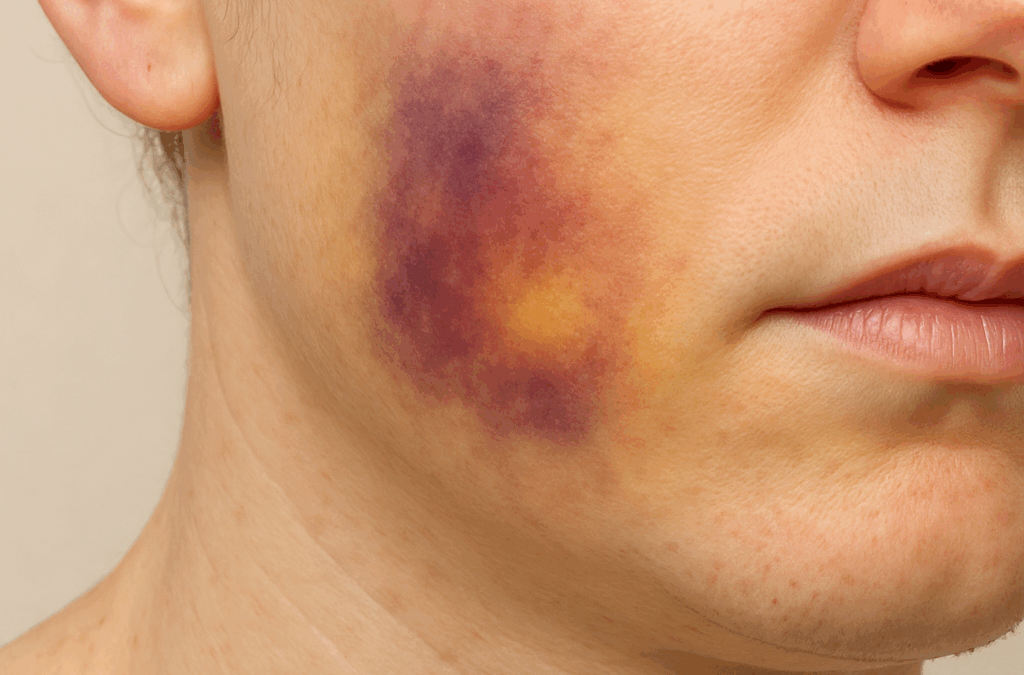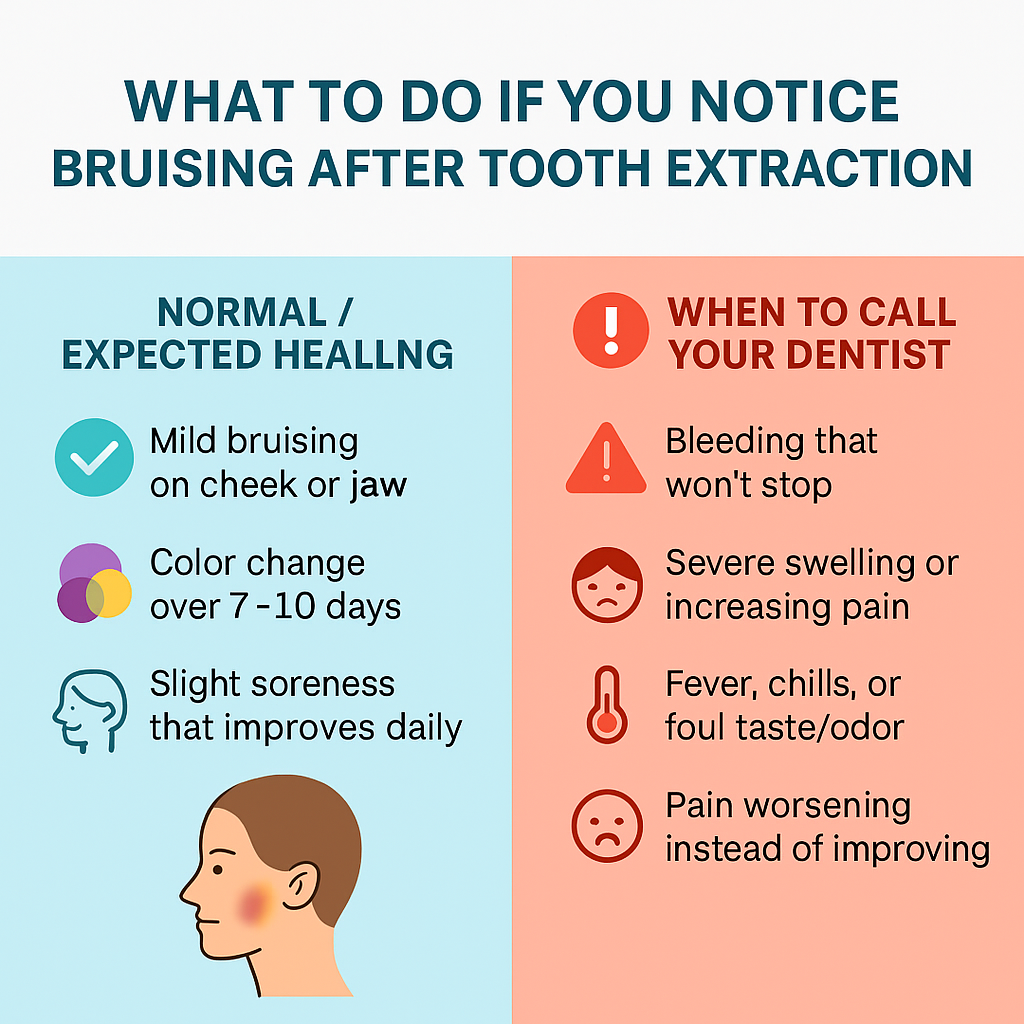Bruising after tooth extraction isn’t always expected, but it does occur often enough that patients should know what it means. While many people anticipate some soreness or swelling after a tooth is removed, the appearance of dark purple, blue, or yellow marks on the cheek or jaw can take them by surprise. The good news is that in most cases, bruising is harmless and resolves on its own. Still, there are times when it signals something that requires your dentist’s attention. This article explains why bruising happens, what to expect during healing, and when to call your dentist.
The Medical Name for Bruising
The clinical term for this presentation is ecchymosis. Ecchymosis describes the discoloration that occurs when blood vessels under the skin or gum tissue rupture, allowing a small amount of blood to leak into surrounding tissues. Patients often find comfort in knowing that what they’re experiencing has a name and is recognized as a common response to tissue trauma.
Why Bruising After Tooth Extraction Happens
Bruising after tooth extraction is not considered the “normal” or anticipated outcome, but it can occur under a variety of circumstances. Some of the most common contributing factors include:
- Complex extractions that require additional pressure, surgical cuts, or tissue stretching
- Teeth with long or firmly anchored roots that resist removal
- Age-related changes, since older adults often have more delicate blood vessels
- Medications such as aspirin, warfarin, or other blood thinners that reduce clotting ability
- Individual healing response, as some people bruise more easily than others
Interestingly, bruising doesn’t always match the difficulty of the case. A complicated surgical extraction may leave no visible bruise, while a relatively easy removal can sometimes result in unexpected discoloration.
What About Bleeding?
Dentists rarely, if ever, dismiss patients while active bleeding is still occurring. Before you leave the office, your dentist or oral surgeon will ensure that a blood clot has formed and that the surgical site is stable. However, bleeding can recur once you are home—most often because aftercare instructions weren’t followed exactly.
Common causes of renewed bleeding include:
- Vigorous rinsing or spitting, which can dislodge the clot
- Drinking through a straw, which creates suction at the site
- Probing the wound with your tongue or fingers
- Smoking too soon after surgery, which interferes with healing
One of the most frequent examples dentists encounter is smoking. Despite clear warnings, some patients step outside immediately after their appointment and light up. This not only risks renewed bleeding but also significantly increases the chance of developing dry socket, a painful complication caused by the loss of the protective clot.
How Long Does Bruising After Tooth Extraction Last?
The timeline for ecchymosis is similar to bruising elsewhere on the body. Most cases follow this predictable pattern:
- Days 1–3: Discoloration appears dark purple, blue, or even black
- Days 4–6: The bruise begins to fade into a greenish hue
- Days 7–10: The bruise takes on a yellow tone before disappearing
For most patients, bruising resolves within 7–10 days, though in some cases it may persist slightly longer depending on the size and depth of the ecchymosis.
Tips to Minimize Bruising and Swelling
While bruising isn’t always preventable, there are steps you can take to reduce the likelihood or severity:
- Apply a cold compress or ice pack to the outside of the cheek for the first 24 hours (20 minutes on, 20 minutes off)
- Keep your head elevated when resting to reduce blood flow to the area
- Avoid aspirin unless prescribed, as it may increase bleeding and bruising
- Follow your dentist’s aftercare instructions carefully
- Eat soft foods and avoid chewing near the extraction site
These steps won’t guarantee you’ll avoid ecchymosis, but they can help support smooth healing.
When Should You Be Concerned?
Most cases of bruising after tooth extraction resolve without any intervention. However, you should call your dentist if you notice:
- Severe or worsening swelling instead of gradual improvement
- Bleeding that does not stop with firm pressure on gauze
- Pain that is increasing rather than decreasing after a few days
- Fever, chills, or general malaise
These signs may point to infection or another complication that requires attention. Prompt communication with your dental provider is always the safest course of action.
FAQ: Common Patient Concerns
Can I prevent bruising after tooth extraction?
Not completely. Some factors are outside your control, such as your age or how your body reacts to trauma. However, following aftercare instructions and avoiding risky behaviors like smoking can minimize your risk.
Does bruising mean something went wrong with my extraction?
Usually not. Bruising is simply your body’s natural response to minor trauma and does not mean that the procedure was poorly performed.
What if I’m on blood thinners?
Be sure to inform your dentist of all medications before treatment. In many cases, adjustments aren’t needed, but your dentist may take additional precautions to reduce your risk of bleeding or bruising.
The Bottom Line
While bruising after tooth extraction is not the expected outcome, it does happen—and sometimes even after procedures that seemed routine. The condition, known as ecchymosis, usually fades within a week to ten days. By following instructions carefully, using cold compresses, and avoiding behaviors like smoking, most patients recover without complication. If anything seems unusual, don’t hesitate to contact your dentist for reassurance or additional care.
External resource: American Dental Association – Tooth Removal





